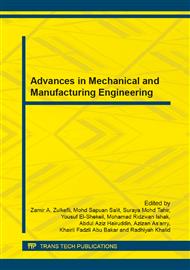p.157
p.164
p.170
p.176
p.182
p.189
p.197
p.204
p.210
Vibration Gear Fault Diagnostics Technique Using Wavelet Support Vector Machine
Abstract:
Intelligent diagnostics tool for detecting damaged bevel gears was developed based on wavelet support vector machine (WSVM). In this technique, the existing method of SVM was modified by introducing Haar wavelet function as kernel for mapping input data into feature space. The developed method was experimentally evaluated by vibration data measured from test rig machinery fault simulator (MFS). There were four conditions of gears namely normal, worn, teeth defect and one missing-teeth which has been experimented. Statistical features were then calculated from vibration signals and they were employed as input data for training WSVM. Fault diagnostics of bevel gear was performed by executing classification task in trained WSVM. The accuracy of fault diagnostics were evaluated by testing procedure through vibration data acquired from test rig. The results show that the proposed system gives plausible performance in fault diagnostics based on experimental work.
Info:
Periodical:
Pages:
182-188
Citation:
Online since:
June 2014
Authors:
Price:
Сopyright:
© 2014 Trans Tech Publications Ltd. All Rights Reserved
Share:
Citation:


